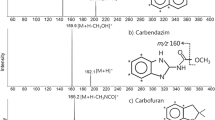Summary
For the determination of trace amounts of carbamate insecticides in vegetables the combination of liquid chromatography with post column chemical derivatization (chemical reaction detector) is used. In a two step reaction detector the carbamates are firstly saponified in 0.01 M sodium hydroxide at 80°C with a reaction time of 30sec. To this mixture OPA reagent is added to detect the methylamine generated in the saponification. Optimization strategies for this reaction are demonstrated. At a temperature of 80 °C a reaction time of 80 sec is sufficient for quantitative transformation of the methylamine. The peak dispersion can be reduced and hence the detection limit improved by decreasing the diameter of the tubes and by diminishing dilution through the addition of reagent. A 1∶24 ratio of reagent to column (reactor) effluent is possible with cyclone-type mixers.
The quantitation of carbamates in different vegetables is demonstrated. The detection limit is 20ppb at a signal to noise ratio of 10∶1.
Similar content being viewed by others
References
W. P. Cochrane inR. W. Frei, J. V. Lawrence, Chemical Derivatization in Analytical Chemistry, Vol. 1, Plenum Press, New York (1981).
W. P. Cochrane, J. Chrom. Sci.17, 124 (1979).
E. Möllhoff, Pflanzenschutz-Nachrichten “Bayer”28, 3 (1975).
K. A. Ramsteiner, W. D. Hörmann, J. Chromatogr.104, 439 (1975).
H. A. Moye, T. W. Wade, Anal. Lett.9, 801 (1976).
H. A. Moye, S. J. Scherer, P. A. StJohn, Anal. Lett.10, 1049 (1977).
R. T. Krause, J. Chrom. Sci.16, 281 (1978).
R. T. Krause, J. Chromatogr.185, 615 (1979).
K. M. Hill, R. H. Hollowell, L. A. Dal Cortivo, Anal. Chem.56, 2465 (1984).
M. Roth, Anal. Chem.43, 880 (1971).
M. Roth, A. Hampai, J. Chromatogr.83, 353 (1973).
S. S. Simons Jr., D. F. Johnson, J. Am. Chem. Soc.98, 7098 (1976).
H. Engelhardt, U. D. Neue, Chromatographia15, 402 (1982).
H. Engelhardt, B. Lillig inJ. Krull ed., Post column reaction detectors, Dekker, New York (1986).
H. Engelhardt, B. Lillig, J. High Res. & Chrom. Com.8, 531 (1985).
R. D. Voyksner, J. T. Bursey, E. D. Pellizari, J. Chromatogr.312, 221 (1984).
G. Görlitz, Ph.D. Thesis, Saarbrücken (1980).
H. Engelhardt, R. Klinkner, Pres. Z. anal. Chem.319, 277 (1984).
Author information
Authors and Affiliations
Additional information
Thesis B. Lillig, Saarbrücken, 1984
Rights and permissions
About this article
Cite this article
Engelhardt, H., Lillig, B. Optimization of a reaction detector for analysis at the femtomol level of carbamate insecticides by HPLC. Chromatographia 21, 136–142 (1986). https://doi.org/10.1007/BF02311741
Received:
Accepted:
Published:
Issue Date:
DOI: https://doi.org/10.1007/BF02311741




